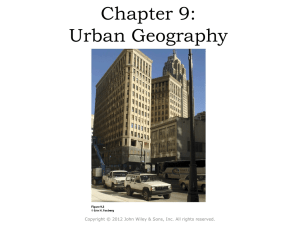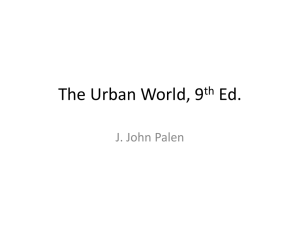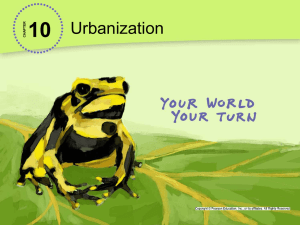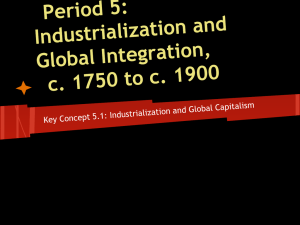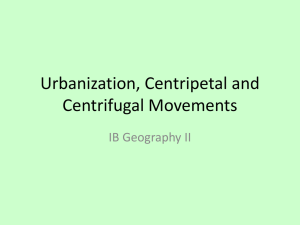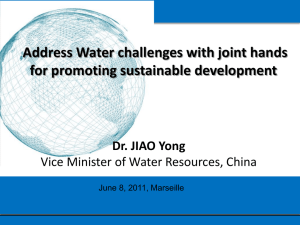Urbanization and Environment: A Comparative Study
advertisement
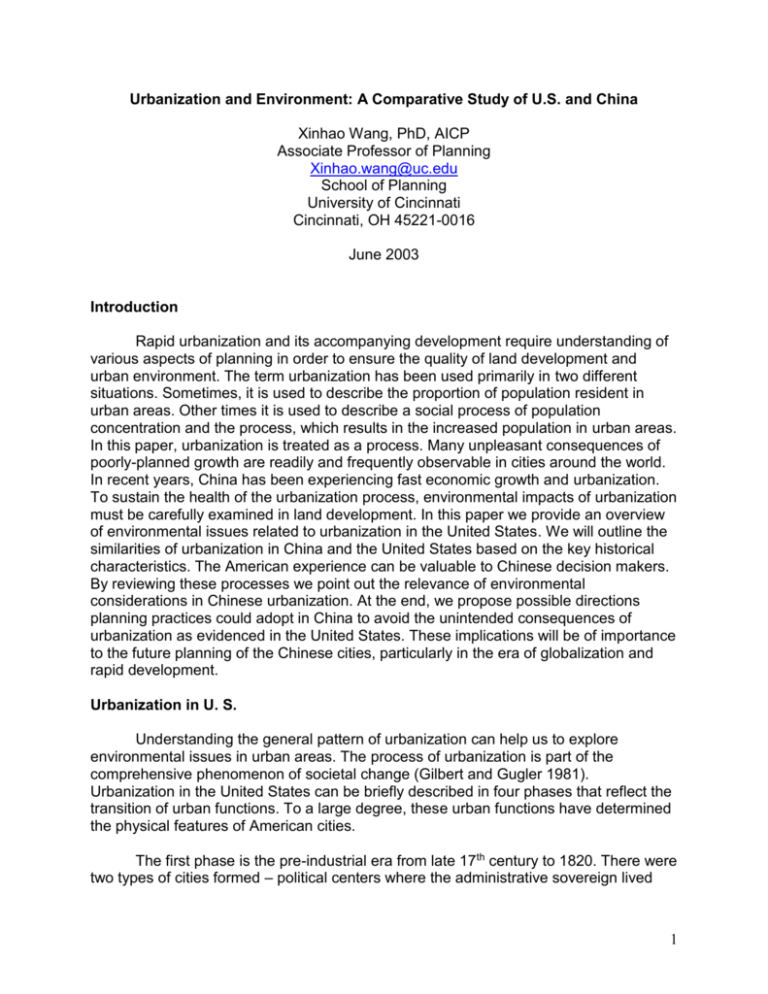
Urbanization and Environment: A Comparative Study of U.S. and China Xinhao Wang, PhD, AICP Associate Professor of Planning Xinhao.wang@uc.edu School of Planning University of Cincinnati Cincinnati, OH 45221-0016 June 2003 Introduction Rapid urbanization and its accompanying development require understanding of various aspects of planning in order to ensure the quality of land development and urban environment. The term urbanization has been used primarily in two different situations. Sometimes, it is used to describe the proportion of population resident in urban areas. Other times it is used to describe a social process of population concentration and the process, which results in the increased population in urban areas. In this paper, urbanization is treated as a process. Many unpleasant consequences of poorly-planned growth are readily and frequently observable in cities around the world. In recent years, China has been experiencing fast economic growth and urbanization. To sustain the health of the urbanization process, environmental impacts of urbanization must be carefully examined in land development. In this paper we provide an overview of environmental issues related to urbanization in the United States. We will outline the similarities of urbanization in China and the United States based on the key historical characteristics. The American experience can be valuable to Chinese decision makers. By reviewing these processes we point out the relevance of environmental considerations in Chinese urbanization. At the end, we propose possible directions planning practices could adopt in China to avoid the unintended consequences of urbanization as evidenced in the United States. These implications will be of importance to the future planning of the Chinese cities, particularly in the era of globalization and rapid development. Urbanization in U. S. Understanding the general pattern of urbanization can help us to explore environmental issues in urban areas. The process of urbanization is part of the comprehensive phenomenon of societal change (Gilbert and Gugler 1981). Urbanization in the United States can be briefly described in four phases that reflect the transition of urban functions. To a large degree, these urban functions have determined the physical features of American cities. The first phase is the pre-industrial era from late 17th century to 1820. There were two types of cities formed – political centers where the administrative sovereign lived 1 and commerce and finance centers where agricultural surplus were assembled, traded and redistributed (Melosi 1980). People gathered in those cities for security, or to exchange goods, services and ideas. Cities became markets for agricultural products and subsequently locations for supplementary industries such as flour milling and shipbuilding. Those cities became economic, political and cultural centers. The second phase of urbanization started as early as 1820 when industrial cities emerged as the dominant urban form. During the beginning of industrial revolution, cities were concentrated with manufactories that helped to increase the gross national product significantly. Industrial expansion contributed directly to urban pollution. From the late nineteenth century until 1920, American industries were concentrated in the Northeast. New cities such as Pittsburgh, Cleveland and Milwaukee began to experience rapid growth and vast economic prosperity. Some old cities, such as Boston and Philadelphia, also attracted major industries. The value added by manufacturing increased ten-fold in the half-century, almost trebling the increased value of farm products (McKelvey 1963). For the most part, proximity to large cities meant the difference between economic success and failure. The increasing use of machines led to much of the agricultural labor unnecessary and the most of farm workers had moved to cities for better job prospects and opportunities. At this time, neither the city authorities nor businessmen did much to confine factories to industrial areas or to segregate the most polluted industries from residential communities. People of different income levels lived as neighborhoods. The third urbanization phase started about 1920 as a product of accelerating technological revolution, such as the electric power, the automobile and the telephone. If we say that industrial revolution helped attract people to concentrate in cities, technological revolution made it possible to diffuse people and industry to a much wider area (Hauser and Schnore 1965). Manufacturing plants in cities were moved to rural/suburban areas, cities in less developed regions, or to cities in developing countries. The original industrial cities have been transformed to the core of much larger metropolitan areas functioning as the social and economic centers beyond the local significance and become part of the regional, national and world economics. While the cities experienced the increase of their influencing power, substantial numbers of city residents moved to suburban regions (Mohl 1997 p211). For example, between 1950 and 1990, St. Louis lost 54% population, Detroit lost almost one-half of its 1950 population of about 1.8 million, Pittsburgh and Cleveland lost 45% of their population. In the central cities, financial institutions and service sectors, such as retails, office, restaurants, government, education and medical care etc., gradually replaced manufacturing industries. The fourth phase started about the third quarter of 20th century. The unique feature separates this phase from the others is that by now urban population stopped increasing while areas with urban services kept expanding. Many service sectors, such as government offices, business offices, schools and medical care moved to suburbs. While new jobs were created the job opportunities in central cities kept declining. Meanwhile, the need for face-to-face transaction and for centrally located office space is 2 diminished (Lampard 1983). The difference between urban population and rural population in suburbs became fuzzy. Someone working in a factory or a financial institution may live thirty miles away from the central city in a detached house with all the services used to be in urban only – telephone, electricity, tap water, sewerage service, garbage pickup, neighborhood parks and entertainments. While some cities have maintained as service and financial centers, many other cities are left with hollow areas of abandoned buildings and contaminated land. The increasing number of towns within or beyond metropolitan boundaries manifests this pattern. What is commonly known as the “Edge City” phenomenon (Garreau 1988) has given rise to the creation of a new urban landscape characterized by the loss of sense of place and identity, the rise of urban sprawl, and particularly office development. According to Garreau (1988), “by the mid-1980s, there was far more office space in Edge Cities around America’s largest metropolis, New York, than there was at its heart—midtown Manhattan” (p.5). In the United States, the resurgence of the urban movement or the “back-to-thecity movement” (Sanchez and Dawkins, 2001) has been concomitant with a series of government policies that encourage city living. The revitalization of the inner-city areas, gentrification of the distressed neighborhoods, public-private partnerships, Enterprise Zones programs, infill development projects, have all targeted old, deteriorating downtown areas of many American cities. Even major federal programs including the Great Society programs and the War on Poverty programs of the 1950s and 1960s were predominantly urban in nature. While these programs have targeted a wide range of urban problems, they vary significantly in terms of their scopes and scales. For example, the Enterprise Zones programs have attempted to lure businesses into moving to poor neighborhoods, while gentrification policies aim to create more appealing residential enclaves and social amenities for the middle-income population who live in the distressed inner-city neighborhoods. Urbanization and Environment Urban environmental problems are typically related to the level of intensity of human activities – a function of population density and activity type. Environmental problems related to urbanization can be broadly categorized into four groups: 1) health problem for individuals; 2) waste generation (and disposal); 3) Pollution (at both local and regional levels); and 4) urban sprawl. The history of urbanization in the United States can be examined again from an environmental perspective. The population of cities in the pre-industrial era was relatively small compared to that in the industrial era. For example, at the beginning of the eighteenth century, 7000 people lived in Boston, the largest city in the U.S. New York City housed 5000 people (Nash 1997). A few concerns about urban environmental issues were primarily related to health, especially in conjunction with epidemic diseases, waste, and bad water. Some attempts were made to regulate waste disposal and water pollution, such as a committee led by Benjamin Franklin during the mid 1760s in Philadelphia. Another type of environmental issue concerned nuisances, for example, the coal smoke, particularly 3 from smithies and blacksmith shops, adversely affected people’s comfort, health, and peace. Due to the nature of the industrial process, industrial cities experienced environmental challenges posed by rapid large-scale industrialization and urbanization that were never experienced before, such as overcrowded tenements, congested traffic, health, smoky skies, wastes, polluted waterways, and noise (Melosi 1981). The efforts to deal with environment issues during the second urbanization phase were limited to the provision of vital services and waste disposal. Examples include programs to tap pure water sources and construct modern sewer systems. By 1880, the refuse problem gained public recognition as a major environmental issue. The initial reaction was that “out of sight, out of mind.” For instance, New York city dumped its refuse into the ocean, and for many years, continued to rely on ocean dumping as a primary means of disposal. The consequence was realized later – the accesses to the harbor were often clogged, the beaches on the New Jersey shoreline looked like cesspools. Sanitary landfill became a primary disposal method in 1920s (Melosi 1981). The manufactory demand for energy led to the uses of coal that resulted in the smoky skies of the industrial city in the late nineteenth and early twentieth centuries. At the beginning, people simply accepted smoky skies as an indication of progress and prosperity. Efforts to control smoke pollution gained momentum in mid 1890s when the sky remained black with soot and the din made it difficult to think, eat, or sleep. At this time, the reformers gained public and official support (Melosi 1981) and alternative fuels, such as natural gas, began replacing coal. In 1900, 40 percent of the pollution load on American rivers had an industrial origin. By 1968 that figure increased to 80%. The volume of sewage and industrial waste that poured into the New Jersey’s Passaic River forced the city of Newark to abandon the river as a source of water supply. Pollution also ruined commercial fishing in the area, and soon homes along the water way disappeared. During hot weather the river emitted such a stench that many factories were forced to close down. The burden of urban waste, along with the rapidly rising social costs that were imposed upon the metropolitan environment, exceeded the traditional delivery system (Havlick 1974). For example, cities along the Great Lakes took drinking water from the lakes and at the same time, discharged sewage and other wastes to the lakes and tributaries through combined sewer systems. Kelbaugh (2002) asserts that urban sprawl reflects the historical propensity of Americans to depend on expansion, growth, and the new start as a way to solve difficult problems. Cherished by abundant space and resources, Americans feel no reason to crowd together in small dwellings in tightly packed cities. Automobiles are now deeply rooted in American culture. Together with the extensive publicly funded highway system, urban sprawl significantly increased the mobility and made it easy to move away from cities. The expansion of urban area leads to the high vehicle miles traveled. Although efforts have been made to increase the fuel efficiency of automobiles, it is 4 outstripped by the explosive growth in use of automobiles. The total amount of fuel consumption has significantly increased. The market forces also aggravate the problem for businesses to maintain their profit margins within urban areas. Numerous government policies showed that the financial costs of renovating or replacing existing structures exceed the cost for building in Greenfields outside the urban cores. Numerous federal, state and local policies have (directly or indirectly) promoted urban sprawl. Zoning that separates different land uses and divides an areas into large segments that are monocultures, i.e., residential, commercial, industrial, culminate in urban sprawl. American metropolises are sprawling at rates similar to the levels of traffic congestions. As urbanization takes place in the flood plain, much of the natural storage and absorption capacity are lost through the process of draining or filling a wetland. With less of the surface land available for infiltration, an increase in volume and rate of runoff is generated from roads, rooftops, driveways, parking lots, and other hardened surfaces. Urbanization in China The urbanization process in China can be traced back to thousands of years ago. Many Chinese cities have long histories of serving as political, cultural and market centers. The impact of industrialization on Chinese urbanization can be described in three stages. The first stage is at the turn of the 20th century, as foreigners started to setup factories in China. Meanwhile, Chinese entrepreneurs started their industries to compete with foreign enterprises. After the communist party took over the country in the middle of the 20th century, the central government adopted a central-planning approach and set up a national goal of “self-sustained” economy. Many cities were developed as “productive” cities along the coast as well as in inland as part of national defense strategy. Special emphasis was placed on heavy industries including iron and steel, mining, and machinery. The Chinese officials clearly considered industrialization as a precondition for creating productive cities. Indeed, industrialization in China epitomized the only viable option for the country’s transformation from a feudal, agrarian society into a modern urban state. Aimed at industrial productivity and modernization, the Chinese officials focused on planning and building productive cities. Chinese officials viewed productive cities as the spatial concentration of heavy industries. In hindsight, the creation of these cities has been accomplished at the expense of livability and the quality-of-life. Pollution is the unintended consequences of heavy industrialization in urban China. Since the 1970s, the government has initiated several industrial restructuring programs to alleviate the negative externalities of rapid urban growth (Ng and Xu, 2000). Little, however, has been reported in the way of diminishing the industrial composition (Chang, 1998: 17-18). Cities still largely house heavy and pollutant industries. The last stage of the industrial cities in China began in late 1970s. This era marks the adoption of the National Reform policy. A new group of 14 coastal cities 5 emerged to primarily support export products, such as Shanzhen. During this stage, marked the labor and capital forces became increasingly footloose. The enactment of the new policies and the rise of the market economy in China (Ng and Xu 2000) accentuated the rural-urban migration and helped provide new employment opportunities in the urban China (Liu and Wei 1997: 96). Since 1990, the Chinese urbanization has taken two parallel paths. On the one hand, several mega cities, such as Beijing, Shanghai and Guangdong, are taking the approach to transfer to global cities serving as financial and political centers. On the other hand, many small cities have been developed to increase diversity in commercial, and residential urban areas. Meanwhile, several mega cities, such as Beijing, Shanghai and Guangzhou, have seen the increasing push for consumption. Examples include an increase in the automobile usage, household services, which lead to congestion and large in-migration of people from rural villages and towns (Zhejiang Cun). American Lessons Applicable to China The review of the urbanization process in the two countries shows that in both countries urban functions have transformed from administrative/commercial to industrial and then to service-oriented. This transformation has impacted the geographic distribution of cities, meaning that a few major cities were broken down to several smaller cities at the metropolitan borders. Dissimilarities between the two countries also abound. In the United State, the urbanization process has reached it’s a point that the momentum has changed from concentration to decentralization while in China, the urbanization process is still attracting people to cities. Another factor that distinguishes the urbanization processes between the two countries is the global information, political, economic, technological, and environmental context. During the accelerative American urbanization phase in the twentieth century, there was no other part of the world had gone through the same process for Americans to learn from, there was no strong global effect on the American cities. Currently, there are international organizations that provide stimulation and assistance in economic growth and urbanization. Many technologies that were not available 50 years ago are readily available now for solving urban problems. The most significance is that the American lessons and experiences can be used to support a less painful and more desirable urbanization process in China. Equipped with those experience and knowledge of population, resources and urban lives, China has the opportunity of aspiring for higher levels of living. There are six lessons from the American urbanization process that would help guide the Chinese urbanization. Lesson One – Respect nature and understand the resource limitation The American urbanization process demonstrates that government policies and life styles could contribute to environmental problems driven by urbanization – the detachment of urban life from nature and increasing burdens on the scarce resources. Along with technology advancement and improved services, people tend to think that resources are un-exhaustible –turning on the tap to get water, turn the switch to light the 6 room. Garbage disappears from the garbage cans every day. When you are cold, you may simply turn on the heat and turn on the air conditioner when you are hot. Government programs also contribute to the habit of ignoring nature. People can build houses on flood plain knowing that government has built structures to protect them. Lesson Two – Internalize environmental factors The American urbanization process demonstrates a history of reaction to environmental problems. The three receptacles for urban pollution – air, water, and land are convenient places to dump unwanted materials, worthy of attention only when a problem arises (Keyes 2000). Starting from epidemic health problem, to sewerage, smoky skies, municipal waste, flooding, and water and air qualities. Many of the problems were results of not including environmental cost in initial development decisions. More recent policies have tried to tie environmental factors with urban development. For example, ISTEA and the subsequent TEA-21 tie urban air quality to federal funding. Urban pollution has many causes, not just the usual culprit of population growth. Economics, technology, industry, scientific expertise, and political and cultural values all contribute to the production of urban wastes. The means used to combat pollution are the product of scientific ingenuity and public concern, economic constraints and legal regulations, individuals and public policy (Tarr 1996 in Keyes 2000). These experiences show that environmental health consequences of rapid industrialization such as hazardous waste management, air pollution, occupational health, will be faced in cities in most developing countries (Hasan and Khan 1999; Leitmann 1994, 1995). In fact, to a certain degree, many of these environmental problems have already appeared in Chinese cities. It is important for Chinese to recognize these problems and consider them in decision-making. Lesson Three – Implement a balanced transportation system The automobile industry that pushed for private automobile in conjunction of the Federal policy of developing interstate highways was responsible for the suburbanization in the United States. While it stimulated economic growth, the cost is too high. The problems of urban sprawl not only reflected in congestion and taking up greenspace, it also drain the resources that can be used in cities such as education, the arts, parks, housing. We have seen a tendency in China, which resemblances to the American trend. If so, the problem will be rise to an even more severe level. While the areas of the two countries are similar (more than 9 million square kilometers), the population in China is about five times more than that in the United States. The American urbanization has shown that constant widening and expending streets and highways are accompanied by increased congestion problems. This experience should be indication that alternative modes of transportation are necessary. 7 Lesson Four – Coordinate government control and market force The driving forces for urban development in America are the unfettered market forces and competition for consumption. The notion of “the more you spend the more you save” also contributes to the urge for over-consumption. The federal income tax reduction for home mortgage interest encourage the construction of single family houses, most often in suburbs. The interstate highways make the inexpensive land on the urban fringe easily accessible. Federal grants have allowed the extensive construction of sewers for suburbia. The market forces also lead to that the most favored solution to waste disposal was usually the cheapest technology that often exacerbated the problems. Within the political and economic context in China, we propose a coordinated government control and market forces. While the market forces often pay attention to the short term gain, government policies should pay more attention to the long-term sustainability. Lesson Five – Make good plan and follow through The American urbanization process has been typically characterized by intermittent periods of boom and bust, and hollowing out of the inner-city areas. The population migration started with a centripetal pattern from rural to cities. A dual direction movement that people moving to suburbs from rural and city followed it. Now it becomes a centrifuge movement that people are moving further away from suburbs. Such sequence is driven by the desire that people always want to move for better. At the early stage of urbanization, more opportunities attracted people to cities. As urbanization brought people prosperity, cities themselves became congested and crowded. Those people who could afford started to move to suburbs. The job opportunities in urban areas still attracted people from rural, only this time they stopped at the suburbs. Gradually the problems originally associated with cities started to appear in suburbs. Meanwhile, the advancement of technology made it possible to have urban services in rural areas. Not surprisingly, those people who could afford started to move further out. Some may argue that this may not necessarily be a problem because people should move for the better. The problem is not that people moved, rather, it is a consequence of migration. Brownfields in downtown areas are cases in point. As another example, while there are not enough students for urban schools, schools in suburb are too crowded to offer normal education. The future of the urban development in China remains ambiguous. The population differential between the two countries adds to this ambiguity. As the most populated country in the world, China’s urban areas remain highly dense. The population density in most Chinese cities is also growing due to the rural-urban migration. This trend has been intensified due to growing market economy (Ng and Xu 2000). Currently, the rural-urban migration or as some call the “floating population” 8 should be examined within a broader context of political-economic forces in China. Scholars have already warned the substandard and illegal housing construction as one of the consequences of rural-urban migration (Shen 2002: 369). Therefore, the question is whether the market-driven expansion of the Chinese urban landscape will witness characteristics similar to the American cities, i.e., abandoned urban areas, ghettoization of the inner-city areas, brownfield sites and so on. A balanced urban system, which consists of big, medium and small cities should be what planners plan for. At the same time increasing the living standards and job opportunities in rural areas will also help to maintain a healthy urban system in China. Since the 1980s, the urban expansion is not solely limited to the centrally planned and state-run initiatives. Other venues have been explored. For example, the growth of townships and village enterprises has played a major role in directing and shifting local resources away from large cities to these areas. Furthermore, in recent years, foreign investment has complemented—or supplanted in some cases— especially in the absence of a local or internal driving forces of growth (Christerson and Lever-Tracy 1997: 570). Such investments have provided townships with new opportunities for the development of infrastructure and service delivery in the rural areas, i.e., housing, health, and schools among other things. This new wave of investment opportunities might engender changes in form of the rural township landscapes, and giving them a chance of avoiding to copy their urban form after large cities. Reference Chang, Sen-Dou. 1998. Beijing: Perspectives on Preservation, Environment, and Development. Cities. 15(1): 13-25. Christerson, Brad and Constance Lever-Tracy. 1997. The Third China? Emerging Industrial Districts in Rural China. Joint Editors and Blackwell Publishers Ltd. Garreau, Joel. 1988. Edge City: Life on the New Frontier. Doubleday, New York. Gilbert, Alan and Josef Gugler. 1981. Cities, Poverty, and Development: Urbanization in the Third World. London: Oxford University Press. Hasan, Samiul and Khan, M. Adil. 1999. Community-Based Environmental Management in a Megacity: Considering Calcutta. Cities. 16(2): 103-110. Hauser, Philips M. and Schnore, Leo F. 1965. The Study of Urbanization. New York: John Wiley & Sons, Inc. Havlick, S. W. 1974. The Urban Organism: The City's Natural Resources from an Environmental Perspective. New York: McMillan Publishing Co. Inc Kelbaugh, Douglas S. 2002. Repairing the American Metropolis. Seattle: University of Washington Press. Keyes, J. 2000. A Place of Its Own. Journal of Urban History 26(3): 380-390. Lampard, Eric E. 1983. The Nature of Urbanization, in Fraser, Derek and Sutcliffe, Anthony (eds) The Pursuit of Urban History, London: Edward Arnold. Leitmann, J. 1994. The World Bank and the Brown Agenda: Evolution of a Revolution. Third World Planning Review. 16: 117-127. 9 Leitmann, J. 1995. A Global Synthesis of seven urban environmental profiles. Cities. 12: 23-39. Liu, Xiaoli, and Wei, Liang. 1997. Zhejiangcun: Social and Spatial Implications of Informal Urbanization on the Periphery of Beijing. Cities. 14(2): 95-108. McKelvey, Blake. 1963. The Urbanization of America, 1800 – 1915. New Brunswick, NJ: McKelvey, Blake. 1963. The Urbanization of America, 1800 – 1915. New Brunswick, NJ: Melosi, Martin V. (ed.) 1980. Pollution and reform in American cities, 1870-1930, Austin: University of Texas Press. Melosi, Martin. V. 1981. Garbage in the Cities: refuse, reform, and the environment : 1880-1980, College Station, TX : Texas A&M University Press. Mohl, Raymond A. 1997. The Making of Urban America. Wilmington, DE: Scholarly Resources Inc. Nash, Gary B. 1997. The social evolution of preindustrial American cities. In Mohl, Raymond A. (ed.) The Making of Urban America, 2nd ed., Wilmington, DE: Scholarly Resources Inc. Ng, Mee Kam and Xu, Jiang. 2000. Development Control in Post-Reform China: the Case of Liuhua Lake Park, Guangzhou. Cities. 17 (6): 409-418. Sanchez, Thomas W. and Dawkins, Casey J. 2001. “Distinguishing City and Suburban Movers: Evidence from the American Housing Survey,” Housing and Policy Debate. 12(3): 607-631. Shen, Jianfa. 2002. A Study of the Temporary Population in Chinese Cities. Habitat International 26: 363-377. 10




